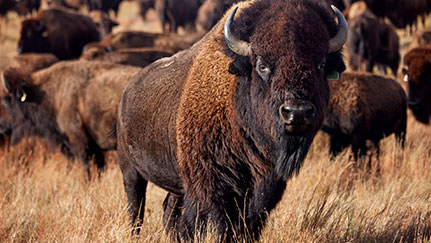What are some differences between bison and cattle?
Bison grazing and stocking rates are similar, and it’s often a safe bet to use beef stocking rates when determining grazing needs for a bison herd. Herd dynamics are hugely important in building a buffalo herd; they’re matriarchal animals with a “lead cow” in each herd.
“Bison are very social animals with a pecking order in a lot of herds with a matriarch cow that leads the herd,” Matheson said. “But at the end of the day, we're raising an undomesticated species.”
The animal’s instincts enable bison to thrive in harsh winters. But when dry conditions trim grazing availability, bison can be difficult to support given they’re not easy to move to another region to graze, like cattle. Maintaining diverse herd genetics is another challenge in raising bison.
Processing bison entering the protein supply chain poses other challenges. They’re large animals, but carcass sizes are typically smaller than fed cattle, with more hair, hide and skeletal structures to handle during processing. That means not every small-town locker or processor can handle bison.
Necessities for raising bison
There’s a lot of upside for bison producers in 2022 and beyond. Consumer demand is high, creating opportunity for ranchers interested in adding them to their herds. It takes the right land, production and management capabilities, financing and commitment to raising successful stock.
Risk management is a big part of that equation. That’s where Erich Ehrlich comes in. The Director of Agribusiness for Renaissance Insurance in Windsor, Colorado, helped develop liability and livestock coverages for bison producers around a decade ago. It’s a key need in starting or growing a bison herd.
“There was coverage before. It just wasn’t user-friendly and didn’t cover all liabilities in one package. Working with Nationwide, we were able to offer policies that accounted for the unique things about raising bison,” said Ehrlich, a Nationwide Premiere Farm Certified agent. “You have to have a really good business plan and the right finances. The NBA partnership with Nationwide helps producers get the right coverage for their operations.”
Want to find out more? Talk with a Nationwide Farm Certified agent today.
